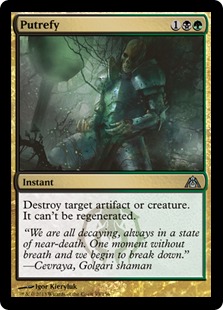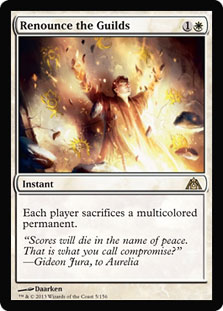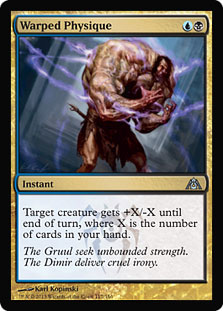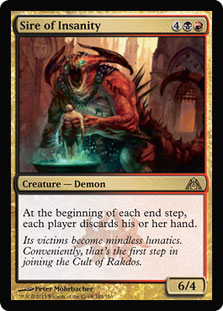Now that we know all of the cards in Dragon’s Maze, it’s time to think about what this set will do to Standard. Standard is getting large at this point, so this set represents a relatively small change to the format as a whole. As a result, I would expect a few new decks to emerge, but mostly old decks will just get updated. This is particularly true in the short term, which given the nature of Magic is what we really need to concern ourselves with as tournament players. As a result, I’m going to start by assuming things remain fairly constant, and I’m going to consider how these cards will impact existing decks and matchups, ignoring new decks that will emerge and cards that are worth building around for now.
First, I want to look at low-impact utility spells. What I mean by this is cards that slot into existing decks as subtle upgrades to cards they’re already using that don’t change much about the deck. In this case, I specifically mean slightly tweaking a removal suite.
Putrefy
This is the most important removal spell in Dragon’s Maze. Murder is actually seeing some amount of play, and this card is easier to cast if you’re both colors, doesn’t allow regeneration, and can kill artifacts. That’s a huge upgrade. Murder doesn’t see a lot of play because it’s hard to pull the trigger on a card that is that underpowered, but some people play it because the format really needs it. There are a lot of creatures that need to get killed, and many of them are immune to a lot of the best two mana removal. Putrefy is good enough that you can play it to kill those creatures without feeling bad about it.
What does that mean?
Well, the number of three mana removal spells in people’s decks is going to go up substantially. That won’t necessarily make them better in all places. Decks filled with creatures that were already vulnerable to two mana removal spells that can punish people for playing clunkier spells will get better. In other words, the big winner here might be Naya Blitz—it won’t play Putrefy, but everyone who does will be worse against it.
Big losers include creatures that previously relied on being difficult to kill like Olivia Voldaren and, more importantly, artifacts that cost more than three mana. Specifically, Witchbane Orb and Staff of Nin should become much less exciting, particularly against Jund.
Reanimator won’t be able to play this much because it doesn’t kill enchantments—not being able to remove Rest in Peace will make it a worse choice than the fourth Abrupt Decay. Also, I think Reanimator is too vulnerable to Blitz to make room for something like this. It has a small Olivia problem sometimes, but this isn’t the answer.
Jund Aggro can play this. When you’re ahead on board, you can spend a whole turn killing the creature your opponent plays to stabilize. That said, it probably won’t play many because it doesn’t want that much removal.
Midrange Jund is the best home for this. It wants to be able to deal with as many different things as possible, and being able to answer Witchbane Orb is a real perk. I don’t think many people will have access to four of them, but I expect to see a few.
Renounce the Guilds
I think this card might be very good. Against The Aristocrats/Act 2 it kills Cartel Aristocrat; Boros Reckoner; Falkenrath Aristocrat; Sorin, Lord of Innistrad; and Obzedat, Ghost Council. Those are all difficult to kill, and they don’t want to lose any of them.
Against Jund it kills Huntmaster of the Fells and Olivia Voldaren. Again, those are the cards I was looking to kill in the first place.
Against Reanimator it’s a little worse because sometimes it will just kill a Deathrite Shaman, Lotleth Troll, or Centaur Healer, but one upside there is that they can’t save the Centaur Healer with Restoration Angel—they’ll just have to sacrifice it anyway. Other times it will kill Obzedat, which is definitely the goal.
Against Jund Aggro it kills Rakdos Cackler, Burning-Tree Emissary, Dreg Mangler, and Falkenrath Aristocrat. Realistically, any time it’s likely to kill Falkenrath Aristocrat, you’re probably happy to have a few of them.
Against Naya Blitz it’s pretty bad; it basically just kills Burning-Tree Emissary. This is the biggest strike against it (like Putrefy—good times for Naya Blitz so far).
The biggest reason to play this might be as an answer to Geist of Saint Traft.
Outside of the things I’ve mentioned thus far, it kills Detention Sphere and Domri Rade.
Like Putrefy, I don’t think anyone will want a full playset of Renounce the Guilds, but a cheap and fairly reliable answer to Falkenrath Aristocrat, Boros Reckoner, and Geist of Saint Traft is a big deal, especially for G/W decks that don’t have a lot of other options.
I expect this to be best in U/W/x control decks, especially with Snapcaster Mage. It will make life substantially worse for The Aristocrats (especially by giving Bant an answer to Falkenrath Aristocrat) and Geist of Saint Traft decks (Hexproof).
Warped Physique
There are a lot of cards in Magic that do things like this, but none in Standard. All the two mana black removal in Standard cares about weird things like colors and creature types instead of the toughness of the creature you’re trying to kill (except Orzhov Charm, I suppose). It’s very easy to keep this card big enough to kill most things, and you can work to let it answer whatever you need to. The fact that this is a –X means that it kills Falkenrath Aristocrat, which is still a big deal.
The more I think about it, this is probably the best new removal spell and maybe the best removal spell in all of Standard, and having access to it does a lot to give Dimir a purpose. Unlike the other spells I’ve written about, this one is excellent against Naya Blitz.
I’m very excited about this card. It will be interesting to see what this does to Esper Control’s removal since you don’t really want to cut Azorius Charm because cycling it is important and some sacrifice effects are nice. Still, I think this should become the second most played removal spell after Azorius Charm in that archetype.
Next, I want to look at the only other noncreature spell that I think really matters.
Plasm Capture
This slots perfectly into Bant Control, which can cast it on turn 3 with a Farseek, and passing with four mana up will leave people guessing between this, Restoration Angel, and even potentially Advent of the Wurm. If you counter a three mana spell with this, you can untap, miss a land drop, and cast Angel of Serenity. This isn’t dreaming big; this is just countering a spell at the first possible opportunity and casting an expensive spell with the lands you have in play, and if your game plan is based on ramping off this, you can do it even if their spell was uncounterable. That’s going to be a game winning play a lot of the time, and if you do it slightly later on a slightly bigger spell, you might be able to play Angel of Serenity and pass with mana up to cast another counterspell.
If you put this in one of the Omniscience decks—well, let’s just say I think it might make those decks playable. If you counter anything reasonable, you can untap and cast whatever absurd bomb you have in your hand. It even fixes your mana!
In the real world with normal decks, this is usually just going to fuel Sphinx’s Revelation, but that should almost always win the game so it doesn’t sound too bad. The matches where both players have Sphinx’s Revelation and Plasm Capture are going to get very tricky.
The biggest question with this card is going to be figuring out how big to go since you want to do something absurd after you successfully Plasm Capture something but you don’t want to fill your deck with uncastable cards the rest of the time.
Finally, some notable creatures:
Aetherling
In his preview article, Sam Stoddard made it clear that R&D believes this card is the real deal, and they’re probably right. The trick is casting it with mana up, which costs seven, and even then the opponent might have two removal spells for it. The best way to keep it safe is to cast it off Plasm Capture, and in a lot of matchups there’s a good chance that’s actually the best thing you can do with that mana. As Sam said, this is pretty unimpressive against aggro unless you basically already have the game locked up, but against control this can be an easy way to end a game.
The biggest impact of Aetherling will be to make faster decks better and slower decks worse in proportion to how much play this card sees. This is the kind of card that starts an arms race in control mirrors where both players have to play cards that are good in the mirror and bad elsewhere to keep up. As a result, all of their decks are worse against everyone else. One of the amazing things about Magic is that printing a good blue card can be the best way to make blue decks worse.
Blood Baron of Vizkopa
And here we see that exact effect in W/B. This card is probably weaker than Obzedat, Ghost Council, but it might be better against other W/B decks, although despite its protections it doesn’t actually match up that well against Obzedat.
This card is at its best against aggressive white and black decks. When an opponent is putting enough pressure on you that you can’t Blink Obzedat because you need it to block, this comes down and threatens to block and gain four, which is a lot harder to beat than just gaining two.
The fact of the matter is that most of the time this card won’t be as strong as Obzedat, but it isn’t legendary and is a lot easier to cast. The best place for this is probably Esper decks that don’t want to stretch their mana. They can easily splash this and get a similarly powerful bomb against attackers that’s also hard for anyone to remove.
Blood Baron of Vizkopa will particularly outperform Obzedat if Warped Physique and Putrefy, which kill Obzedat but not the Baron, are out in force. Unfortunately, it’s even worse than Obzedat against Thragtusk, which could be a substantial obstacle. It will be at its worst if Mizzium Mortars is particularly popular.
Sire of Insanity
While this is another great tool for Jund, it may not be at its best there. Rakdos’s Return and Slaughter Games have already positioned Jund as a deck that often preys on control, and this is just another tool at their disposal. It’s best with Cavern of Souls, but they usually don’t have that because their creatures have different types and Kessig Wolf Run is better.
So who does want Sire of Insanity? Well, R/B decks that are happy to play Cavern of Souls, naturally. Oddly, those decks currently are Human Reanimator, The Aristocrats, and I suppose R/B Aggro if you acknowledge that as a deck (maybe Spike Jester will help with that, but I’m not optimistic). It’s a pretty exciting option for Human Reanimator or any red Reanimator deck. The only thing better than an uncounterable Sire of Insanity against control may be a turn 4 Sire of Insanity against control, and you may not be too sad to discard that fatty you couldn’t cast.
As for The Aristocrats, it’s not out of the question that it will want something to help out against control since Warped Physique and Renounce the Guilds make their current plan A much worse. While it’s a little expensive, this could be the answer.
Council of the Absolute
There’s a good chance that this card is awesome. The most obvious use for it is naming Sphinx’s Revelation, which I imagine will happen pretty often, but it’s far from the only good thing to do with it. Another particularly sweet play is to name Restoration Angel, and then after you play your two mana Restoration Angel, you can Blink the Council of the Absolute and name something else.
I think the way Standard works right now that Meddling Mage isn’t at its best, so I’m more excited about this card as an accelerator than as a four mana Meddling Mage. But it can do both jobs if you want, and naming Unburial Rites or Angel of Glory’s Rise are certainly real options. Slaughter Games is another fine card to name after sideboarding.
2/4 isn’t a bad size to be in current Standard. Since so many creatures are 3/3s, this can block usefully, which it definitely needs to be able to do. Even if this only gives you two mana once, accelerating a big Sphinx’s Revelation or an Angel of Serenity by two mana can be absolutely huge.
While this guy will be a pain in control mirrors, I don’t think he makes them worse in other places the way that Aetherling does. I think there’s a real chance this is just a good card that fits pretty well in any U/W deck (even aggressive decks might play it to name Supreme Verdict).
Those are the cards that I think will best fit into existing Standard decks. Overall, I think they’re bad news for The Aristocrats, a mixed blessing for control, and surprisingly good for Naya Blitz considering it won’t be playing any of them.
I definitely think Dragon’s Maze will shake things up more than this article by itself implies—we’re just not there yet. I focused on a small subset of the changes to make a highly impactful set manageable to process. In reality, I think we’ll see new decks based on some combination of Voice of Resurgence, Advent of the Wurm, and Scion of Vitu-Ghazi, as well as a few based on some of the new legends, and that’s just the beginning.
You’ll see more on all that in the coming weeks.
Thanks for reading,
Sam
@samuelhblack on Twitter








